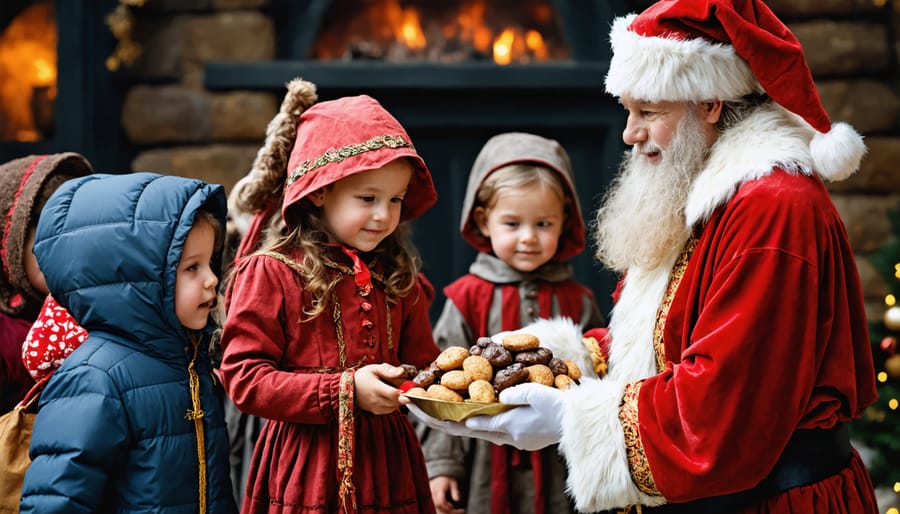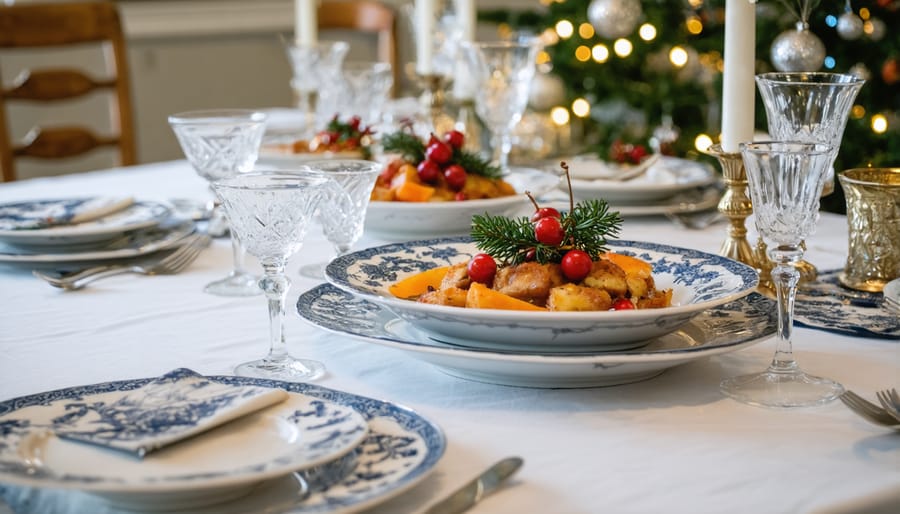
Step into a world where centuries-old traditions blend with modern festivities in Belgium’s enchanting holiday season. From the cobblestone streets of Brussels to the medieval squares of Bruges, Belgian holiday celebrations transform ordinary moments into meaningful holiday celebrations that warm both heart and home.
Picture cozy evenings filled with the aroma of speculoos cookies and mulled wine, while Sint Nikolaas (the Belgian Santa) prepares for his December 6th visits to excited children. Unlike many Western celebrations, Belgian holiday traditions stretch beyond Christmas Day, creating a festive season that begins in early December and extends through Three Kings Day in January.
What makes Belgian celebrations truly special is their perfect balance of religious customs and secular merriment. Whether it’s families gathering for elaborate Christmas Eve feasts featuring bouquettes (Belgian waffles) and cougnou (bread shaped like baby Jesus), or friends meeting at enchanting Christmas markets that illuminate city centers, these traditions create a magical atmosphere that captures the true essence of the holiday spirit.
In Belgium, every region adds its own unique touch to these celebrations, making each experience authentically local yet universally welcoming. Welcome to a journey through Belgium’s most beloved holiday traditions, where every custom tells a story and every celebration creates lasting memories.

The Magic of Saint Nicholas Day
Speculoos and Sweet Traditions
No Belgian holiday season would be complete without the irresistible aroma of freshly baked speculoos wafting through the air. These spiced shortcrust cookies, deeply embedded in Belgian tradition, take center stage during Saint Nicholas Day celebrations on December 6th. Crafted with a distinctive blend of cinnamon, nutmeg, ginger, and cloves, speculoos cookies are often pressed into charming molds depicting Saint Nicholas or traditional winter scenes.
In Belgian households, children eagerly place their shoes by the fireplace or near the door on the eve of Saint Nicholas Day, hoping to find them filled with speculoos, chocolate figures, and other sweet treats the next morning. The traditional chocolate letters, usually representing the child’s first initial, are another beloved treat that brings joy to little ones.
Modern Belgian chocolatiers have elevated these holiday treats to an art form, creating elaborate chocolate Saint Nicholas figures and creative interpretations of classic speculoos. Many families still gather to bake these cookies using recipes passed down through generations, filling their homes with the sweet scents and warm memories that make Belgian holiday traditions so special.
Gift-Giving Customs
In Belgium, gift-giving takes on a unique charm, especially during the celebration of Saint Nicholas (Sinterklaas) on December 6th. Unlike many other countries where Santa Claus is the star of the show, Belgian children eagerly await visits from Saint Nicholas, who arrives not by sleigh but by steamboat from Spain, accompanied by his helper, Zwarte Piet.
Children place their shoes by the fireplace or near the door on the evening of December 5th, often filling them with carrots, hay, or sugar cubes for Saint Nicholas’s horse. In return, they wake up to find their shoes filled with candies, chocolates, and small toys. Traditionally, good children receive treats while naughty ones might find twigs (though nowadays, it’s mostly treats for everyone!).
Many Belgian families also exchange presents on Christmas Eve or Christmas Day, but it’s usually a more modest affair compared to the Saint Nicholas celebrations. There’s a beautiful tradition where families gather to exchange thoughtfully chosen gifts, often accompanied by heartfelt cards and plenty of hot chocolate. Some families even organize special treasure hunts or riddles leading to the presents, making the experience even more magical for children and adults alike.

Christmas Markets and Festive Decorations
Regional Market Specialties
As you explore Belgium’s enchanting Christmas markets, each region offers its own unique flavors and crafts that blend seamlessly with broader European Christmas traditions. In Brussels, you’ll find delicate handmade lace ornaments and the famous speculoos cookies, while Bruges specializes in exquisite chocolate pralines and traditional wool crafts. The markets in Ghent are known for their locally produced jenever (Belgian gin) and cuberdons, cone-shaped purple candies that locals affectionately call “nose-shaped candies.”
Antwerp’s markets showcase diamond-inspired decorations and creative takes on traditional waffles, while Liège is famous for its unique pearl sugar waffles and locally crafted wooden toys. In the Ardennes region, you’ll discover artisanal cheeses, wild game pâtés, and handcrafted wreaths made from forest materials.
What makes these markets truly special is how each vendor shares stories about their craft, often passing down recipes and techniques through generations. Don’t forget to try the regional variations of glühwein, each area adding its own special blend of spices and local ingredients to this warming winter drink.
Home Decoration Traditions
Belgian homes transform into magical wonderlands during the holiday season, blending traditional charm with modern elegance. Central to this transformation is the Christmas tree, which Belgian families typically decorate together on December 6th, following Saint Nicholas Day. Unlike the minimalist trends popular in some countries, Belgian festive holiday decorations embrace warmth and abundance.
A traditional Belgian Christmas home features handcrafted ornaments passed down through generations, often including delicate glass baubles and hand-painted wooden figurines. Nativity scenes, or ‘kerststal,’ hold a special place in Belgian homes, commonly displayed beneath the Christmas tree or in a prominent window. These scenes are often elaborate, featuring detailed figurines and authentic moss collected from local forests.
Window decorations play a significant role, with twinkling lights and paper stars creating a welcoming glow that brightens the dark winter evenings. Many families also embrace the tradition of hanging wreaths made from fresh pine branches, adorned with ribbons, pinecones, and small ornaments. The sweet scent of fresh greenery, combined with the warm glow of candlelight, creates that unmistakable Belgian Christmas atmosphere that visitors find so enchanting.
Traditional Belgian Holiday Feast
Christmas Eve Dinner
In Belgian homes, Christmas Eve dinner is a cherished moment that brings families together for an elaborate feast filled with traditional holiday recipes passed down through generations. The celebration typically begins in the early evening, with families gathering around a beautifully set table adorned with festive decorations and candlelight.
The meal often starts with a classic seafood appetizer, commonly smoked salmon or a delicate gray shrimp cocktail. The star of the evening is usually either turkey or game meat, such as pheasant or venison, accompanied by seasonal vegetables and crispy roasted potatoes. Many families serve croquettes filled with cheese or shrimp as a beloved side dish.
For dessert, the iconic Bûche de Noël (Christmas log) takes center stage – a rolled sponge cake decorated to look like a woodland log, filled with buttercream and topped with chocolate bark and sugar decorations. Some families also enjoy speculoos cookies and Belgian chocolates while sharing stories and opening a small gift before midnight.
The evening often concludes with hot chocolate or Belgian coffee, sometimes accompanied by a dash of advocaat (egg liqueur) for the adults. This intimate family dinner sets the perfect tone for the magical Christmas morning to come, creating memories that last long after the holiday season ends.

New Year’s Celebrations
As the clock strikes midnight on December 31st, Belgian homes come alive with the warmth of celebration and cherished traditions. While fireworks light up the sky across major cities like Brussels and Antwerp, families and friends gather for intimate soirées filled with laughter, music, and, of course, incredible food.
The New Year’s Eve feast, or “Réveillon,” is a cornerstone of Belgian celebrations. Traditional dishes include oysters, smoked salmon, and the beloved “oliebollen” – delicious deep-fried dough balls dusted with powdered sugar that fill homes with their irresistible aroma. Many families also serve “cougnou,” a sweet bread shaped like baby Jesus, carrying over the Christmas tradition into the New Year.
At midnight, it’s customary for Belgians to exchange three kisses on the cheek and wish each other “Gelukkig Nieuwjaar” (in Dutch) or “Bonne Année” (in French). Some families maintain the heartwarming tradition of writing personal notes to loved ones, expressing hopes and wishes for the coming year.
The morning of January 1st often begins with a refreshing New Year’s dive into the North Sea at Ostend – a brave tradition that’s gained popularity in recent years. For those preferring to stay warm and dry, the day typically involves visiting family members and sharing more celebratory meals, often featuring traditional vol-au-vent or Belgian beef stew.
As we reflect on Belgium’s holiday traditions, it’s heartwarming to see how these time-honored customs continue to bring families and communities together while adapting to modern times. The blend of old and new creates a magical atmosphere that makes Belgian celebrations truly special. While younger generations might opt for contemporary takes on traditional dishes or incorporate international elements into their festivities, the core values of togetherness, generosity, and celebration remain unchanged.
What makes Belgian holiday traditions particularly charming is their ability to evolve while preserving their authentic character. You’ll still find grandmothers teaching their grandchildren how to make speculoos cookies using centuries-old recipes, even as they embrace new holiday activities and decorating styles. The streets of Belgian cities continue to sparkle with Christmas markets and festive lights, creating that same enchanting atmosphere that has captivated visitors for generations.
In today’s fast-paced world, these traditions offer a precious opportunity to slow down, connect with loved ones, and savor the simple pleasures that make holidays memorable. Whether it’s sharing a warm cup of hot chocolate at a winter market or gathering around the table for a traditional feast, Belgian holiday customs remind us that some things are worth preserving, even as we welcome new ways to celebrate.



